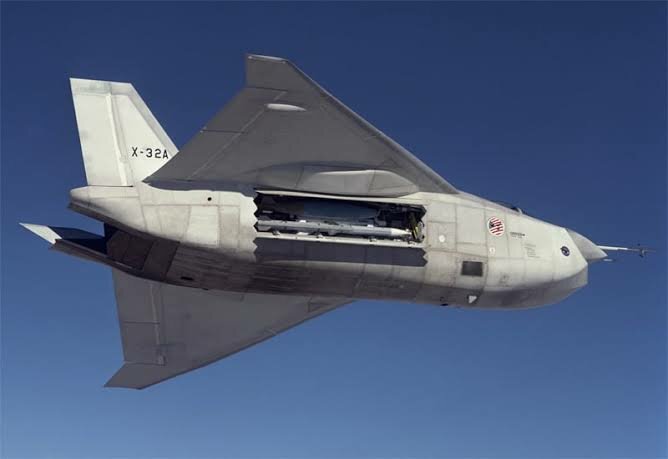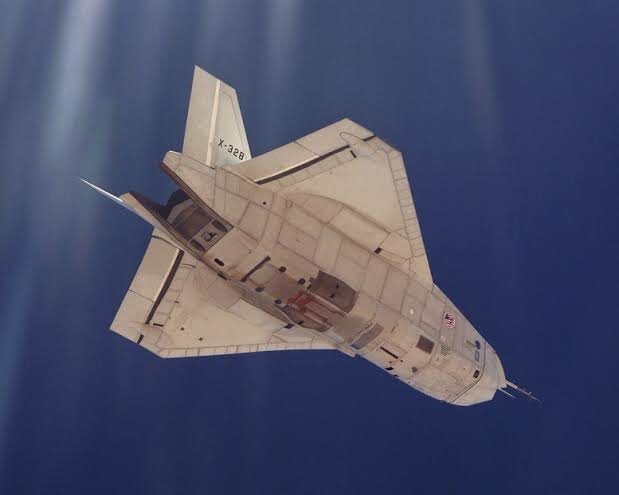If I remember correctly the X-32 met all the JSF program targets as did the X-35.
You aren’t remembering correctly I’m afraid.
The main difference between them was the complexity of the V/STOL method. The X-32 team chose a relatively simple low weight solution
Low weight, low capability. It could barely hover. The weight difference was <2000lb btw, 10%. X-32 appears to have had a more powerful engine btw.
And that’s just wrong, it wasnt stovl “complexity” the main difference - it was the entire conceptual design of the aircraft. Look at the planform, crucially where the engine is, where and how the wing joins the fuselage, the cockpit, what control surfaces you do/dont have. What that means for stability and control and how this thing flies and is manoeuvred.
Everything on X-32 was subordinated to a layout barely moved on from Harrier and hopelessly compromised by the stovl “solution”. Everything on X-35 is a layout that decades of operational aircraft had always shown was the layout for a combat aircraft and a decade plus of R&D looking at options to design a stovl system that worked with the layout, not vica versa.
while the X-35 went with a more complex higher performance solution. The X planes produced didn’t fully represent an operational fighter due to budget constraints.
Nothing to do with budget constraints, they were concept demonstrators to enable a downselect. A level of maturity commensurate with the timeline and desire to then initiate the main program. The planform, STOVL, cv-ctol-stovl commonality (incl conversion), LO and FCS working were what they wanted to see in the flesh before going further. As we saw the X-35 with all its potential took many billions to mature to an operational platform.
Remember that the Joint Strike Fighter program was basically going to provide F-117 stealth capabilities plus air to air (2x 2000lb bombs and 2x AMRAAM) to replace all the Harrier, F-16 and FA-18 fleets. Pretty impressive really!
Using JSF airframes to replace the F-14, F-15 and A-6 and F-111 roles doesn’t seem as good though does it! Shame the JSF program didn’t cover two airframes really. Single engine lightweight to replace Harrier and F-16, then twin engine heavy to replace F-14, F-15 and FA-18. Same gear, but heavy has twice the weapons etc.
That’s two completely different aircraft. The entire point was a single program. Can you point to any such twin program ever?
I always thought that the simpler X-32B/F-32B was the way to go for the UK Harrier replacement.
It was absolute rubbish. Really, this thing had no potential and could hardly carry itself. It’d have been a step back from Harrier.
It quite literally could never have entered service, it would never have met the full (ie not experimental) set of flight requirements (handling etc) and had zero (if not negative) margin to cope with adding systems and development growth etc.
The RAF could have operated them in STOL mode most of the time if bring back weight was the issue on land operations. Even if the internal payload was reduced to 2x 1000lb bombs and 2x AMRAAM as in the F-35B it would have beat the Fleet Air Arm Sea Harrier FA2’s 4x AMRAAM maximum load (6x AMRAAM or 4 plus 2x ASRAAM maybe?).
You are making a huge leap of utterly unsubstantiated faith that it could do that. It couldn’t.
Anyway, I’m a Boeing X-32/F-32 fan!

Enthusaism is one thing, dismissing reality is another. X-32 got absolutely owned by X-35’s demonstrated and potential capability. So much so that X-35 was able to take a decade and a half development program with all the compromises and back steps that imposes and still come out with a credible platform. X-32 never started even close to that place and no amount of fanboism changes that.
Had X-35 failed, the program would almost certainly have been cancelled soon after with STOVL stripped out and a new one started for the USAF/USN. Possibly the latter would have gone sole SH (although this was in serious trouble at the time ?perhaps a little earlier? with flight safety handling/control issues) and so we’d have got a USAF single engine FAsomething. Probably very similar to F-35A in layout as funny old thing, that’s what combat aircraft should look like. Take a punt on LM or Boeing doing/winning that, perhaps the latter would listen to Macair folk this time and design something decent. I guess F-22 would have seen more attention also and not the later cessation of its build.


